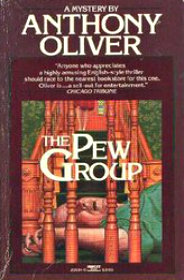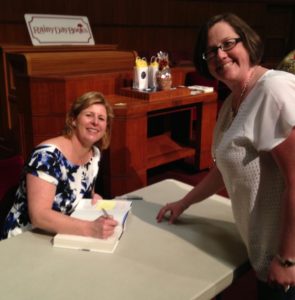Jennifer F. (jfarr5)
Congratulations Jennifer! Your books will be on the way to you soon.
Thank you Mary Potter Kenyon for your interview and for providing the books for this give-away!

This genial whodunit was the 1980 debut novel of an art historian who was an expert in pottery. Oliver literally wrote the book on The Victorian Staffordshire Figure. Before his early death in the late Eighties, he wrote four mysteries, in which he used his knowledge of the business and obsession of collecting antique pottery.
More lust and bawdy couplings than is usual in a cozy mystery do lead to lapses in taste. However, far outweighing this quibble is that this is a genuinely British comic mystery. That is, it features eccentric characters in the English village of Flaxfield, an irrepressible Welshwoman, and a scamp of an Irish tinker. Other funny characters in the Dickensy tradition include a vicar that does spend awful lot of time in conservations with the Creator; a randy spinster; a widow who got that way through murder; gay partners in an antique shop, one of whom is nicknamed “Betsey” Trotwood; and an American millionaire who’s mad about a fabulously valuable Staffordshire figurine called The Pew Group.
The Pew Group goes missing during a wake, which in my English is the feasting and drinking held after the funeral and burial, not the vigil held at the bedside of somebody who has died. Inspector Webber, born in Flaxfield, has returned there for a rest cure and a vacation from a shaky marriage. He teams up with Mrs. Thomas, the incorrigible woman from Cardiff, to identify the thief.
In the first quarter or so of the book the tone is more tetchy and acerbic than I like. The waspishness brought to my mind Robert Barnard, whom I don’t read anymore because his parodies of the conventions of the cozy mystery seem mean-spirited. However, to my relief, Oliver’s tone got more amiable as the book went on. It’s more in the English spirit to be nice, as this reader is totally down with Big Bang Theory Bernadette’s motto, “Being mean is lame, what’s cool is being nice!”
Oliver is a clever, imaginative, and first-rate storyteller. I highly recommend this literate mystery.
Liane Moriarty is one of the authors I have really fallen in love with over the past couple of years. I’ve read five of her books so far and each one has a gripping, need-to-read feel. I know many readers have not been overly complimentary of Truly Madly Guilty but I tend to disagree.

Mirah gets a book signed by Liane Moriarty
I had the pleasure of attending a book event with Liane Moriarty during her promotional tour for Truly Madly Guilty. She was funny, personable, and self-deprecating. I could instantly see how her personality had come through in her books. Moriarty said one common theme for all of her books is guilt and what different people do when they carry a burden of guilt. I thought back to her books I had read and realized that guilt did, indeed, have a some role in every story but in Truly Madly Guilty, guilt is front and center in the plot.
Truly Madly Guilty is about six characters who attend a barbecue where ‘something’ happens that changes their lives. But what happened?! Moriarty does drag out the story and leave the readers wondering for quite a while. I admit, I felt very uncomfortable reading this book most of the time. I had a sinking feeling in my gut during all of the chapters that took place at the barbecue…what was about to happen? I felt nervous and apprehensive the more I read and even though I didn’t really like the characters, I had to keep reading. I had a similar reaction while reading Gone Girl, check out my review to that novel here on the blog. I think when an author has the ability to create such a visceral reaction to a story then she must be doing something right!
The characters in Truly Madly Guilty were not my favorite literary characters. I had a difficult time relating to any of them and that did make it more complicated for me to really care about what happened to them. However, the mystery of the barbecue kept me reading so I decided to give this novel 4 out of 5 stars. For a 5 star Moriarty recommendation, I would suggest The Husband’s Secret.
When thinking about this review I had a difficult time deciding what category to put it in…The Winter Sea is historical fiction, with the feel of chick lit and modern day fiction and a little fantasy thrown in for good measure. I decided to go with historical fiction due to the presence of actual historical figures and events that were integral to the success of the novel. But with all of that said, I hope the readers who claim not to be fans of historical fiction will still give it a chance.
Carrie McClelland is an author conducting research regarding the efforts to restore James Stewart (the young King James) to his throne in Scotland. Beginning her research in France, where James was living in exile, she soon realizes she actually needs to be in Scotland and changes the perspective of her story. Through historical research and family connection, Carrie creates the story of Sophia and her place at Slains Castle, her relationships with various supporters of King James, and her love story that transcends war and exile. The depth of Carrie’s connection to the story, and the way in which the truth is revealed to her, leaves her questioning what she has long believed of her family history.
I think Kearsley has a winner with this novel. She used an interesting format (chapters set in the present day and chapters that were from Carrie’s historical novel that she is writing) and I liked the mirroring of the past in the present. Kearsley carefully weaves together the past and present and makes sure all of the details connect between the past and present. Kearsley created an ethereal love story that left me feeling hopeful and fulfilled with both stories being told. For creating fantastic characters and leaving me satisfied with the story but still wanting more, I give this novel 5 out of 5 stars.

I hesitated to read The Track of Sand, a 2008 mystery that is the twelfth in the series of mysteries starring a Sicilian police inspector. The reason is that the one previous, The Wings of the Sphinx, was so weak. The recurring themes – Salvo’s rocky romance with Livia, globalization as criminal enterprise – felt stale, so I wondered if the series, like The Big Bang Theory, was just going through the motions.
I was pleasantly surprised that international crooks play no part in The Track of Sand. The series hero Salvo Montalbano wakes up one morning to find in his yard the battered carcass of a horse that was beaten to death. Salvo feels admirable grief for the horse and rage at the evil-doing perps. His half-official investigation delves in Mafia schemes and the lifestyles of the filthy rich. A new character, the lovely Rachele Esterman, adds to Salvo’s diversions.
The sense of place still feels authentic and familiar, with Salvo walking on his jetty and sitting on his rock. He still eats local cuisine at Enzo’s trattoria. The translation is extremely smooth and readable, with helpful cultural notes at the end. Camilleri handles skillfully the spectrum of life, from the funny to the horrible, often following each other only in minutes.
The plot, however, is thin and the reveal has a tacked-on feeling. There’s no harm reading this one if human interest and like of characters outplay plot and detecting, but I advise readers new to Camillieri to read – in order, please – The Shape of Water, The Terracotta Dog, The Snack Thief, The Voice of the Violin and Excursion to Tindari.